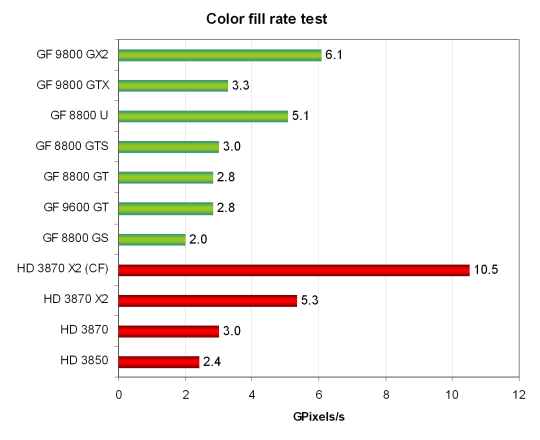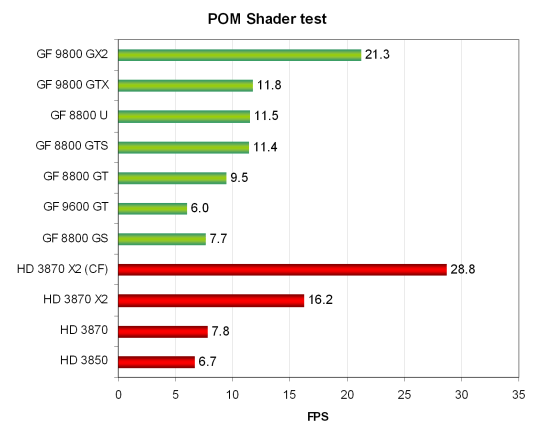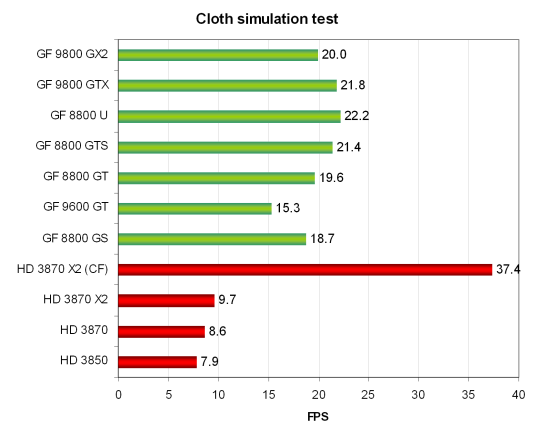Feature Test 2: Color Fill
Color Fill test. It uses a simple pixel shader, which does not limit performance. An interpolated color value is written into the off-screen buffer (render target) with alpha blending. It uses a 16-bit off-screen buffer of the FP16 format, which is often used in games employing HDR, so this is a timely test.
Everything is fine with this test - its results agree with our synthetic tests, taking into account that we use an integer buffer with 8 bits per component, while the Vantage test employs a floating-point 16-bit buffer. So its results are twice as low.
In fact, these numbers reflect memory bandwidth (in case of multiple GPUs multiplied by the number of GPUs for AFR). See how far ahead GeForce 8800 Ultra is. Just like in our tests, it significantly outperforms all G92-based cards and comes close to the dual-GPU card from AMD. The other results also agree with theoretical data, which depend mostly on memory bus width and its clock rate.
Feature Test 3: Parallax Occlusion Mapping
It's one of the most interesting feature tests, as this technique is already used in games. It draws one quadrangle (to be more exact, two triangles) using Parallax Occlusion Mapping that imitates complex geometry. The test uses resource-intensive operations to trace rays and high-res Z maps. This surface is also shaded using the heavy Strauss algorithm. This test uses a very complex and heavy pixel shader with multiple texture lookups during ray tracing, dynamic branches, and complex Strauss lighting algorithms.
As we have mentioned above, this test is interesting because it's one of the popular uses of complex shaders, Crysis employs a similar method. Besides, this test depends on shader power, branching efficiency, and texture fetch rate combined.
NVIDIA solutions are generally faster than their AMD competitors. Only GeForce 9600 GT is slightly outperformed by HD 3850. We can clearly see that the dual-GPU rendering in this test is very efficient, such cards enjoy almost a twofold performance gain here. Interestingly, GeForce 8800 Ultra demonstrates a similar result to top cards on G92. Performance is really limited by the speed of texturing and shader units.
Feature Test 4: GPU Cloth
This test computes physical interactions (cloth simulation) using a GPU. It uses vertex simulation with the help of vertex and geometry shaders, with several passes. Stream out is used to move vertices from one pass to the other. Thus, this feature test benchmarks execution of vertex and geometry shaders, and stream out speed.
We again got strange results in multi-GPU rendering. Neither GeForce 9800 GX2 from NVIDIA nor HD 3870 X2 from AMD gain additional performance from their second GPU in this test. However, for some strange reason, quad-GPU rendering with two HD 3870 X2 cards demonstrates more than fourfold performance gain versus a single HD 3870.
If we discard this result, AMD is not doing well here. All its cards fail to catch up with the slowest NVIDIA card - GeForce 9600 GT, being twice as slow as their competitors. NVIDIA cards also demonstrate strange results - performance difference between the 9600 GT and 9800 GTX is smaller than 1.5 times. I have an impression that performance in this test does not depend on shaders, but on stream out or even vertex performance...
Write a comment below. No registration needed!



